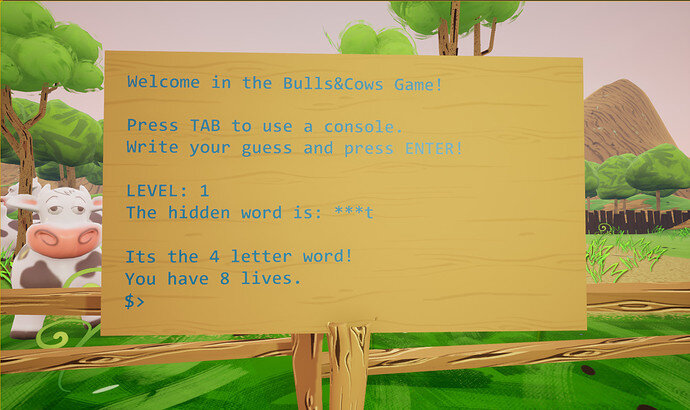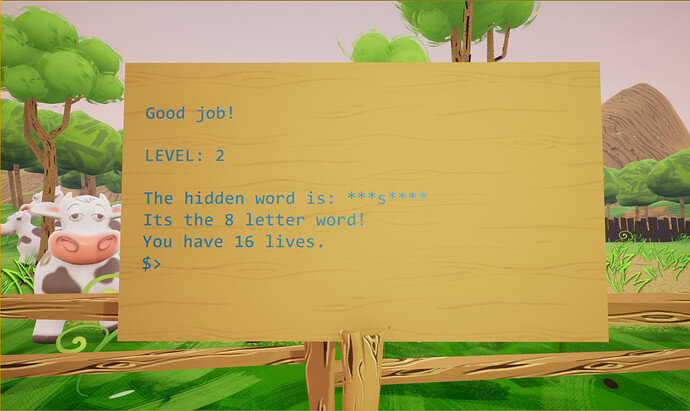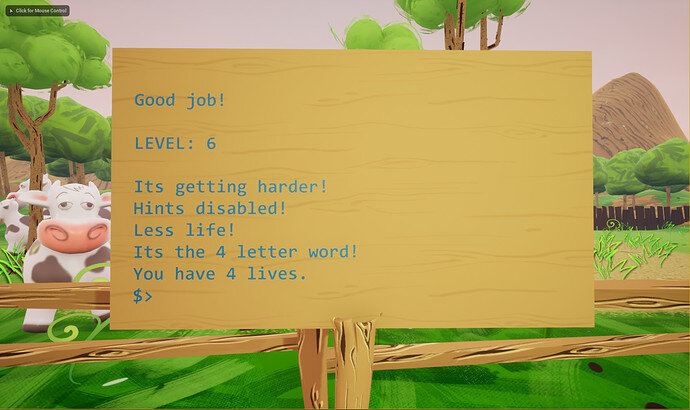This is my BullCowGame (Screens below). Added some extra futures:
- Levels: Starting from 1 and counting +1 on every guessed word. On level 6 the game is harder (Hints disabled and less life)
- Hints: The player gets one random letter as a hint (rest of the letters will be displayed as -> *). Example: Hidden word is LOST and random letter will be [2] in this case its S. Player gets hint as
** S *
Win condition is to reach level 10.
Start:
Next level (if word guessed):
The game getting harder after level 5:
Code bellow:
// Fill out your copyright notice in the Description page of Project Settings.
#include "BullCowCartridge.h"
#include "Misc/FileHelper.h"
#include "Misc/Paths.h"
void UBullCowCartridge::BeginPlay() // When the game starts
{
Super::BeginPlay();
// Transfer words from txt file into an array
const FString WordListPath = FPaths::ProjectContentDir() / TEXT("WordsList/HiddenWordList.txt");
// Get Isograms member variable(array) and declare it with words from HiddenWordList.txt after they fulfills certain conditions
// [](const FString& Word){} means lambda and is equivalent to the bool function
FFileHelper::LoadFileToStringArrayWithPredicate(Isograms, *WordListPath, [](const FString& Word)
{
return (Word.Len() >= 4 && Word.Len() <= 8 && IsIsogram(Word)); // Find words with >=4 letters and <=8 letters AND Isograms
});
SetupGame();
}
void UBullCowCartridge::OnInput(const FString& PlayerInput) // When the player hits enter
{
if (bGameOver) // Restart game if player guess a word or lost the game
{
ClearScreen();
SetupGame();
return;
}
ProcessGuess(PlayerInput); // Checking Player Guess
}
void UBullCowCartridge::SetupGame()
{
// Initializing Variables
HiddenWord = Isograms[FMath::RandRange(0, Isograms.Num() - 1)];
Lives = HiddenWord.Len() * 2;
bGameOver = false;
Levels = 1;
// Welcoming The Player
PrintLine(TEXT("Welcome in the Bulls&Cows Game!"));
PrintLine(TEXT("\nPress TAB to use a console."));
PrintLine(TEXT("Write your guess and press ENTER!"));
PrintLine(TEXT("\nLEVEL: %i"), Levels);
HiddenWordHint(HiddenWord); // Hint for the player
PrintLine(TEXT("\nIts the %i letter word!"), HiddenWord.Len());
PrintLine(TEXT("You have %i lives."), Lives);
//PrintLine(TEXT("The HiddenWord is: %s."), *HiddenWord); // Debug Line
// PrintLine(TEXT("Number of possible words: %i"), Isograms.Num()); // Debug Line
}
void UBullCowCartridge::EndGame()
{
bGameOver = true;
PrintLine(TEXT("\nPress ENTER to play again..."));
}
void UBullCowCartridge::ProcessGuess(const FString& Guess)
{
if (Guess.Len() != HiddenWord.Len()) // Check Right Number Of Characters
{
PrintLine(TEXT("\nWrong number of characters.\nHidden Word is %i characters long."), HiddenWord.Len());
return;
}
if (Guess == HiddenWord) // Check if guess is correct
{
ClearScreen();
PrintLine(TEXT("\nGood job!"));
NextLevel();
return;
}
if(!IsIsogram(Guess)) // Check If guess is Isogram
{
PrintLine(TEXT("\nNo repeating letters. Try again!"), HiddenWord.Len());
return;
}
--Lives;
if (Lives <= 0) // Check if player lost all the lives
{
ClearScreen();
PrintLine(TEXT("\nYou lose!\nCorrect isogram was: %s"), *HiddenWord);
EndGame();
return;
}
// ! Show Number Of Bulls And Cows
// Search trough array letter by letter
FBullCowCount Count = GetBullCows(Guess);
PrintLine(TEXT("You have %i Bulls and %i Cows!"), Count.Bulls, Count.Cows);
PrintLine(TEXT("\nWrong guess, try again! %i lives left!"), Lives);
}
bool UBullCowCartridge::IsIsogram(const FString& Word)
{
for (int32 Index = 0; Index < Word.Len(); Index++) // Loop trough all letters of the guess
{
for (int32 Comparision = Index + 1 ; Comparision < Word.Len() ; Comparision++) // Loop trough next letters of the guess
{
if (Word[Index] == Word[Comparision]) return false; // Compare letters. Return false if they are the same.
}
}
return true; // Return true if letters repeating
}
FBullCowCount UBullCowCartridge::GetBullCows(const FString& Guess) const
{
FBullCowCount CountBullCows;
for (int32 GuessIndex = 0; GuessIndex < Guess.Len(); GuessIndex++)
{
if(Guess[GuessIndex] == HiddenWord[GuessIndex])
{
++CountBullCows.Bulls;
continue;
}
for (int32 OtherLettersIndex = 0; OtherLettersIndex < HiddenWord.Len(); OtherLettersIndex++)
{
if (Guess[GuessIndex] == HiddenWord[OtherLettersIndex])
{
++CountBullCows.Cows;
break;
}
}
}
return CountBullCows;
}
void UBullCowCartridge::NextLevel()
{
++Levels;
if (Levels > 10)
{
ClearScreen();
PrintLine(TEXT("You win!"));
EndGame();
return;
}
HiddenWord = Isograms[FMath::RandRange(0, Isograms.Num() - 1)];
PrintLine(TEXT("\nLEVEL: %i\n"), Levels);
if(Levels > 5)
{
Lives = HiddenWord.Len();
}
else
{
Lives = HiddenWord.Len() * 2;
HiddenWordHint(HiddenWord);
}
if (Levels == 6)
{
PrintLine(TEXT("Its getting harder!\nHints disabled!\nLess life!"));
}
PrintLine(TEXT("Its the %i letter word!"), HiddenWord.Len());
PrintLine(TEXT("You have %i lives."), Lives);
//PrintLine(TEXT("The HiddenWord is: %s."), *HiddenWord); // Debug Line
}
void UBullCowCartridge::HiddenWordHint(const FString& Word) const
{
FString WordHint;
const int32 RandomLetter = FMath::RandRange(0, HiddenWord.Len() - 1);
for (int32 Index = 0; Index < Word.Len(); Index++)
{
if(Index == RandomLetter)
{
WordHint.AppendChar // Add one letter as a hint
(
Word[Index]
);
continue;
}
WordHint.Append
(
"*" // Rest of the letters will be displayed as *
);
}
PrintLine(TEXT("The hidden word is: %s"), *WordHint);
}
Thanks for the course! I really liked this section.




